Victorian Institute of Technology IT NE 2005 Network Attacks Report
VerifiedAdded on 2022/10/16
|7
|1310
|21
Report
AI Summary
This report examines network attacks, focusing on Denial of Service (DDoS) attacks, their mechanisms, and impacts. It explores the reasons behind network attacks, detailing how attackers exploit vulnerabilities to disrupt services and acquire data. The report discusses different types of DDoS attacks, such as HTTP Flood and SYN Flooding, and identifies affected organizations. Furthermore, it covers network security audit tools like Wireshark, explaining their functionalities in identifying vulnerabilities and assisting in network monitoring. The report also outlines the impact of network attacks on organizations, including financial losses and compromised data, and suggests key steps organizations can take to protect their networks and resources, such as performing risk assessments, implementing security policies, and educating users.

Network System Attacks
Author’s Name
Course
Professor’s Name
Date
Author’s Name
Course
Professor’s Name
Date
Paraphrase This Document
Need a fresh take? Get an instant paraphrase of this document with our AI Paraphraser
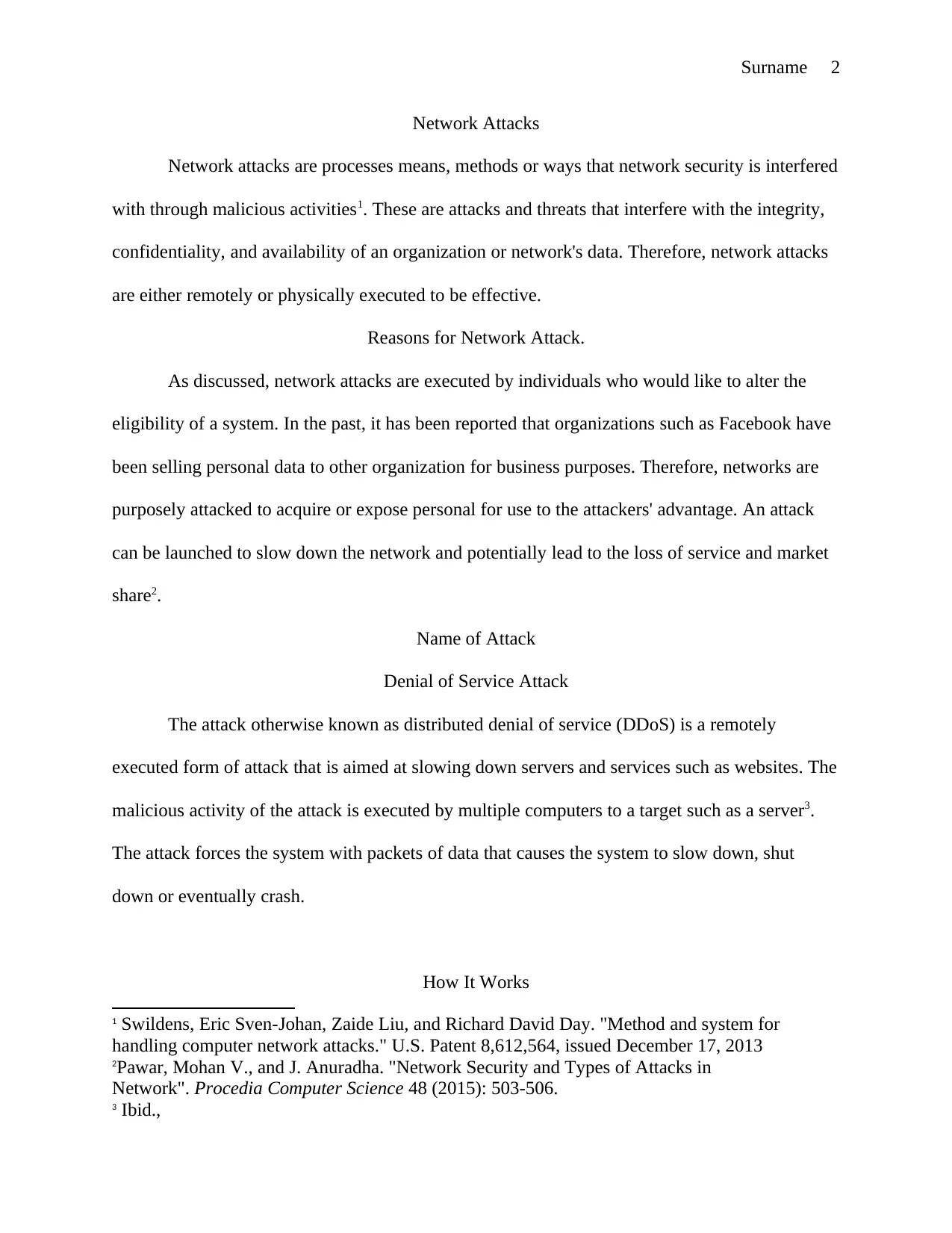
Surname 2
Network Attacks
Network attacks are processes means, methods or ways that network security is interfered
with through malicious activities1. These are attacks and threats that interfere with the integrity,
confidentiality, and availability of an organization or network's data. Therefore, network attacks
are either remotely or physically executed to be effective.
Reasons for Network Attack.
As discussed, network attacks are executed by individuals who would like to alter the
eligibility of a system. In the past, it has been reported that organizations such as Facebook have
been selling personal data to other organization for business purposes. Therefore, networks are
purposely attacked to acquire or expose personal for use to the attackers' advantage. An attack
can be launched to slow down the network and potentially lead to the loss of service and market
share2.
Name of Attack
Denial of Service Attack
The attack otherwise known as distributed denial of service (DDoS) is a remotely
executed form of attack that is aimed at slowing down servers and services such as websites. The
malicious activity of the attack is executed by multiple computers to a target such as a server3.
The attack forces the system with packets of data that causes the system to slow down, shut
down or eventually crash.
How It Works
1 Swildens, Eric Sven-Johan, Zaide Liu, and Richard David Day. "Method and system for
handling computer network attacks." U.S. Patent 8,612,564, issued December 17, 2013
2Pawar, Mohan V., and J. Anuradha. "Network Security and Types of Attacks in
Network". Procedia Computer Science 48 (2015): 503-506.
3 Ibid.,
Network Attacks
Network attacks are processes means, methods or ways that network security is interfered
with through malicious activities1. These are attacks and threats that interfere with the integrity,
confidentiality, and availability of an organization or network's data. Therefore, network attacks
are either remotely or physically executed to be effective.
Reasons for Network Attack.
As discussed, network attacks are executed by individuals who would like to alter the
eligibility of a system. In the past, it has been reported that organizations such as Facebook have
been selling personal data to other organization for business purposes. Therefore, networks are
purposely attacked to acquire or expose personal for use to the attackers' advantage. An attack
can be launched to slow down the network and potentially lead to the loss of service and market
share2.
Name of Attack
Denial of Service Attack
The attack otherwise known as distributed denial of service (DDoS) is a remotely
executed form of attack that is aimed at slowing down servers and services such as websites. The
malicious activity of the attack is executed by multiple computers to a target such as a server3.
The attack forces the system with packets of data that causes the system to slow down, shut
down or eventually crash.
How It Works
1 Swildens, Eric Sven-Johan, Zaide Liu, and Richard David Day. "Method and system for
handling computer network attacks." U.S. Patent 8,612,564, issued December 17, 2013
2Pawar, Mohan V., and J. Anuradha. "Network Security and Types of Attacks in
Network". Procedia Computer Science 48 (2015): 503-506.
3 Ibid.,
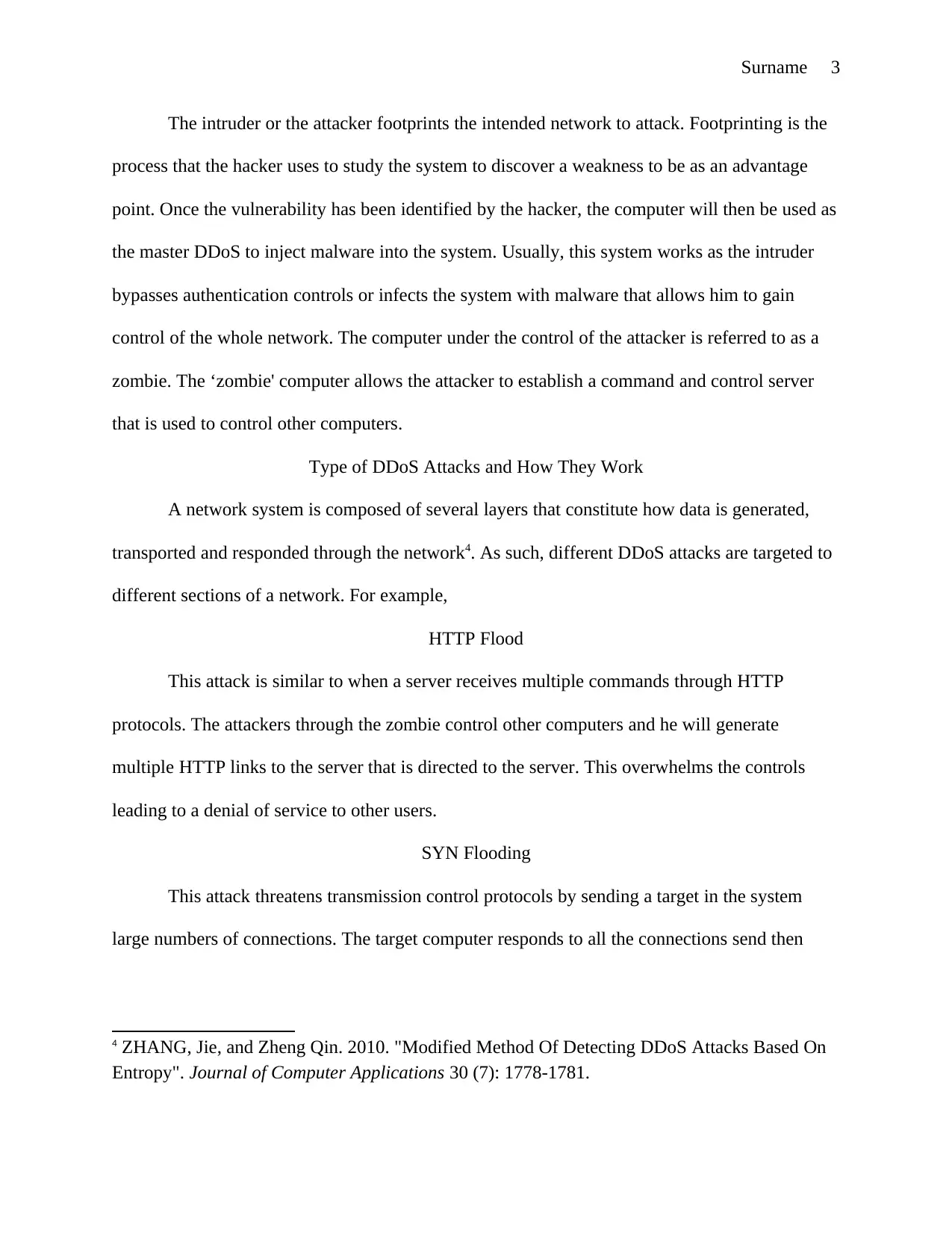
Surname 3
The intruder or the attacker footprints the intended network to attack. Footprinting is the
process that the hacker uses to study the system to discover a weakness to be as an advantage
point. Once the vulnerability has been identified by the hacker, the computer will then be used as
the master DDoS to inject malware into the system. Usually, this system works as the intruder
bypasses authentication controls or infects the system with malware that allows him to gain
control of the whole network. The computer under the control of the attacker is referred to as a
zombie. The ‘zombie' computer allows the attacker to establish a command and control server
that is used to control other computers.
Type of DDoS Attacks and How They Work
A network system is composed of several layers that constitute how data is generated,
transported and responded through the network4. As such, different DDoS attacks are targeted to
different sections of a network. For example,
HTTP Flood
This attack is similar to when a server receives multiple commands through HTTP
protocols. The attackers through the zombie control other computers and he will generate
multiple HTTP links to the server that is directed to the server. This overwhelms the controls
leading to a denial of service to other users.
SYN Flooding
This attack threatens transmission control protocols by sending a target in the system
large numbers of connections. The target computer responds to all the connections send then
4 ZHANG, Jie, and Zheng Qin. 2010. "Modified Method Of Detecting DDoS Attacks Based On
Entropy". Journal of Computer Applications 30 (7): 1778-1781.
The intruder or the attacker footprints the intended network to attack. Footprinting is the
process that the hacker uses to study the system to discover a weakness to be as an advantage
point. Once the vulnerability has been identified by the hacker, the computer will then be used as
the master DDoS to inject malware into the system. Usually, this system works as the intruder
bypasses authentication controls or infects the system with malware that allows him to gain
control of the whole network. The computer under the control of the attacker is referred to as a
zombie. The ‘zombie' computer allows the attacker to establish a command and control server
that is used to control other computers.
Type of DDoS Attacks and How They Work
A network system is composed of several layers that constitute how data is generated,
transported and responded through the network4. As such, different DDoS attacks are targeted to
different sections of a network. For example,
HTTP Flood
This attack is similar to when a server receives multiple commands through HTTP
protocols. The attackers through the zombie control other computers and he will generate
multiple HTTP links to the server that is directed to the server. This overwhelms the controls
leading to a denial of service to other users.
SYN Flooding
This attack threatens transmission control protocols by sending a target in the system
large numbers of connections. The target computer responds to all the connections send then
4 ZHANG, Jie, and Zheng Qin. 2010. "Modified Method Of Detecting DDoS Attacks Based On
Entropy". Journal of Computer Applications 30 (7): 1778-1781.
⊘ This is a preview!⊘
Do you want full access?
Subscribe today to unlock all pages.

Trusted by 1+ million students worldwide
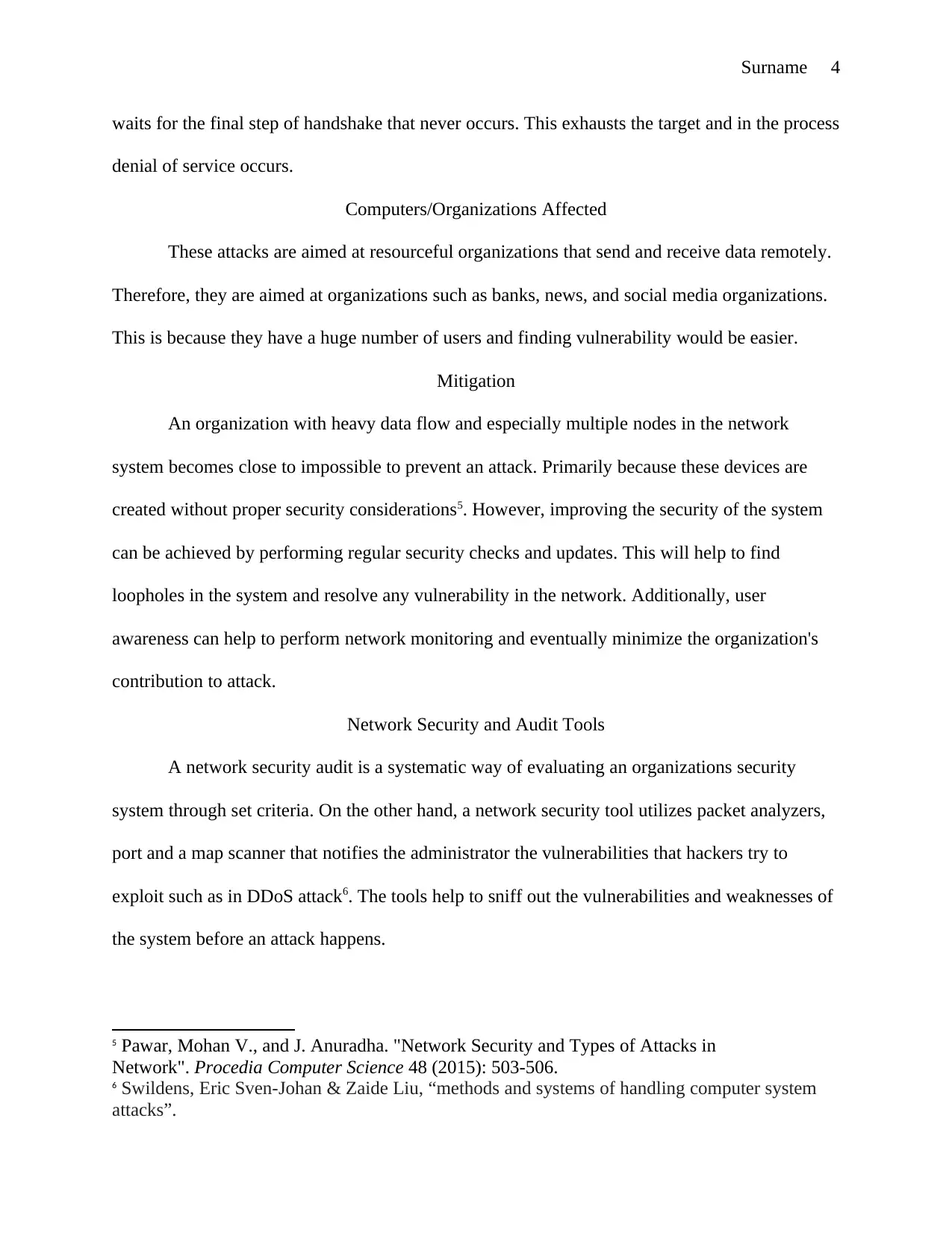
Surname 4
waits for the final step of handshake that never occurs. This exhausts the target and in the process
denial of service occurs.
Computers/Organizations Affected
These attacks are aimed at resourceful organizations that send and receive data remotely.
Therefore, they are aimed at organizations such as banks, news, and social media organizations.
This is because they have a huge number of users and finding vulnerability would be easier.
Mitigation
An organization with heavy data flow and especially multiple nodes in the network
system becomes close to impossible to prevent an attack. Primarily because these devices are
created without proper security considerations5. However, improving the security of the system
can be achieved by performing regular security checks and updates. This will help to find
loopholes in the system and resolve any vulnerability in the network. Additionally, user
awareness can help to perform network monitoring and eventually minimize the organization's
contribution to attack.
Network Security and Audit Tools
A network security audit is a systematic way of evaluating an organizations security
system through set criteria. On the other hand, a network security tool utilizes packet analyzers,
port and a map scanner that notifies the administrator the vulnerabilities that hackers try to
exploit such as in DDoS attack6. The tools help to sniff out the vulnerabilities and weaknesses of
the system before an attack happens.
5 Pawar, Mohan V., and J. Anuradha. "Network Security and Types of Attacks in
Network". Procedia Computer Science 48 (2015): 503-506.
6 Swildens, Eric Sven-Johan & Zaide Liu, “methods and systems of handling computer system
attacks”.
waits for the final step of handshake that never occurs. This exhausts the target and in the process
denial of service occurs.
Computers/Organizations Affected
These attacks are aimed at resourceful organizations that send and receive data remotely.
Therefore, they are aimed at organizations such as banks, news, and social media organizations.
This is because they have a huge number of users and finding vulnerability would be easier.
Mitigation
An organization with heavy data flow and especially multiple nodes in the network
system becomes close to impossible to prevent an attack. Primarily because these devices are
created without proper security considerations5. However, improving the security of the system
can be achieved by performing regular security checks and updates. This will help to find
loopholes in the system and resolve any vulnerability in the network. Additionally, user
awareness can help to perform network monitoring and eventually minimize the organization's
contribution to attack.
Network Security and Audit Tools
A network security audit is a systematic way of evaluating an organizations security
system through set criteria. On the other hand, a network security tool utilizes packet analyzers,
port and a map scanner that notifies the administrator the vulnerabilities that hackers try to
exploit such as in DDoS attack6. The tools help to sniff out the vulnerabilities and weaknesses of
the system before an attack happens.
5 Pawar, Mohan V., and J. Anuradha. "Network Security and Types of Attacks in
Network". Procedia Computer Science 48 (2015): 503-506.
6 Swildens, Eric Sven-Johan & Zaide Liu, “methods and systems of handling computer system
attacks”.
Paraphrase This Document
Need a fresh take? Get an instant paraphrase of this document with our AI Paraphraser
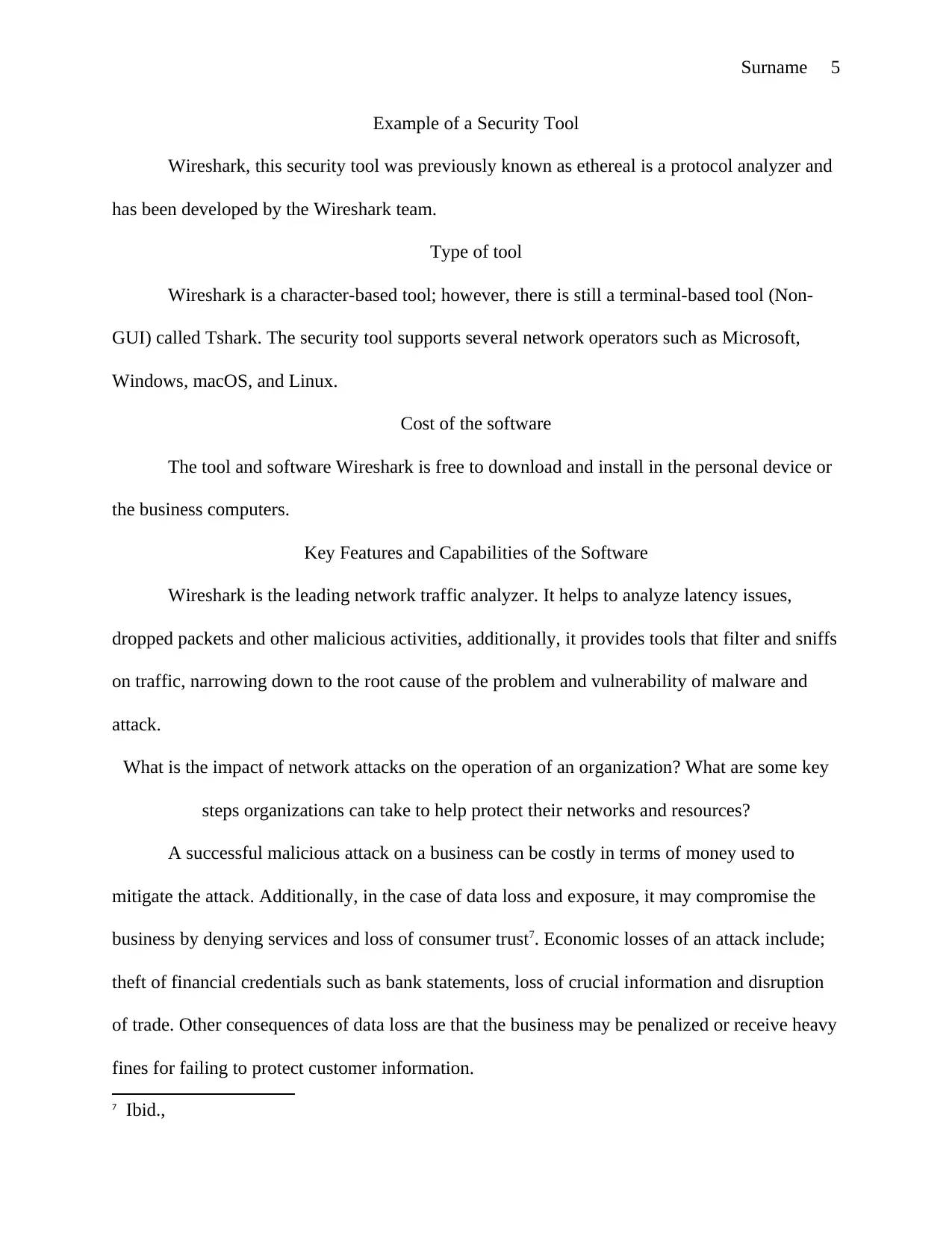
Surname 5
Example of a Security Tool
Wireshark, this security tool was previously known as ethereal is a protocol analyzer and
has been developed by the Wireshark team.
Type of tool
Wireshark is a character-based tool; however, there is still a terminal-based tool (Non-
GUI) called Tshark. The security tool supports several network operators such as Microsoft,
Windows, macOS, and Linux.
Cost of the software
The tool and software Wireshark is free to download and install in the personal device or
the business computers.
Key Features and Capabilities of the Software
Wireshark is the leading network traffic analyzer. It helps to analyze latency issues,
dropped packets and other malicious activities, additionally, it provides tools that filter and sniffs
on traffic, narrowing down to the root cause of the problem and vulnerability of malware and
attack.
What is the impact of network attacks on the operation of an organization? What are some key
steps organizations can take to help protect their networks and resources?
A successful malicious attack on a business can be costly in terms of money used to
mitigate the attack. Additionally, in the case of data loss and exposure, it may compromise the
business by denying services and loss of consumer trust7. Economic losses of an attack include;
theft of financial credentials such as bank statements, loss of crucial information and disruption
of trade. Other consequences of data loss are that the business may be penalized or receive heavy
fines for failing to protect customer information.
7 Ibid.,
Example of a Security Tool
Wireshark, this security tool was previously known as ethereal is a protocol analyzer and
has been developed by the Wireshark team.
Type of tool
Wireshark is a character-based tool; however, there is still a terminal-based tool (Non-
GUI) called Tshark. The security tool supports several network operators such as Microsoft,
Windows, macOS, and Linux.
Cost of the software
The tool and software Wireshark is free to download and install in the personal device or
the business computers.
Key Features and Capabilities of the Software
Wireshark is the leading network traffic analyzer. It helps to analyze latency issues,
dropped packets and other malicious activities, additionally, it provides tools that filter and sniffs
on traffic, narrowing down to the root cause of the problem and vulnerability of malware and
attack.
What is the impact of network attacks on the operation of an organization? What are some key
steps organizations can take to help protect their networks and resources?
A successful malicious attack on a business can be costly in terms of money used to
mitigate the attack. Additionally, in the case of data loss and exposure, it may compromise the
business by denying services and loss of consumer trust7. Economic losses of an attack include;
theft of financial credentials such as bank statements, loss of crucial information and disruption
of trade. Other consequences of data loss are that the business may be penalized or receive heavy
fines for failing to protect customer information.
7 Ibid.,
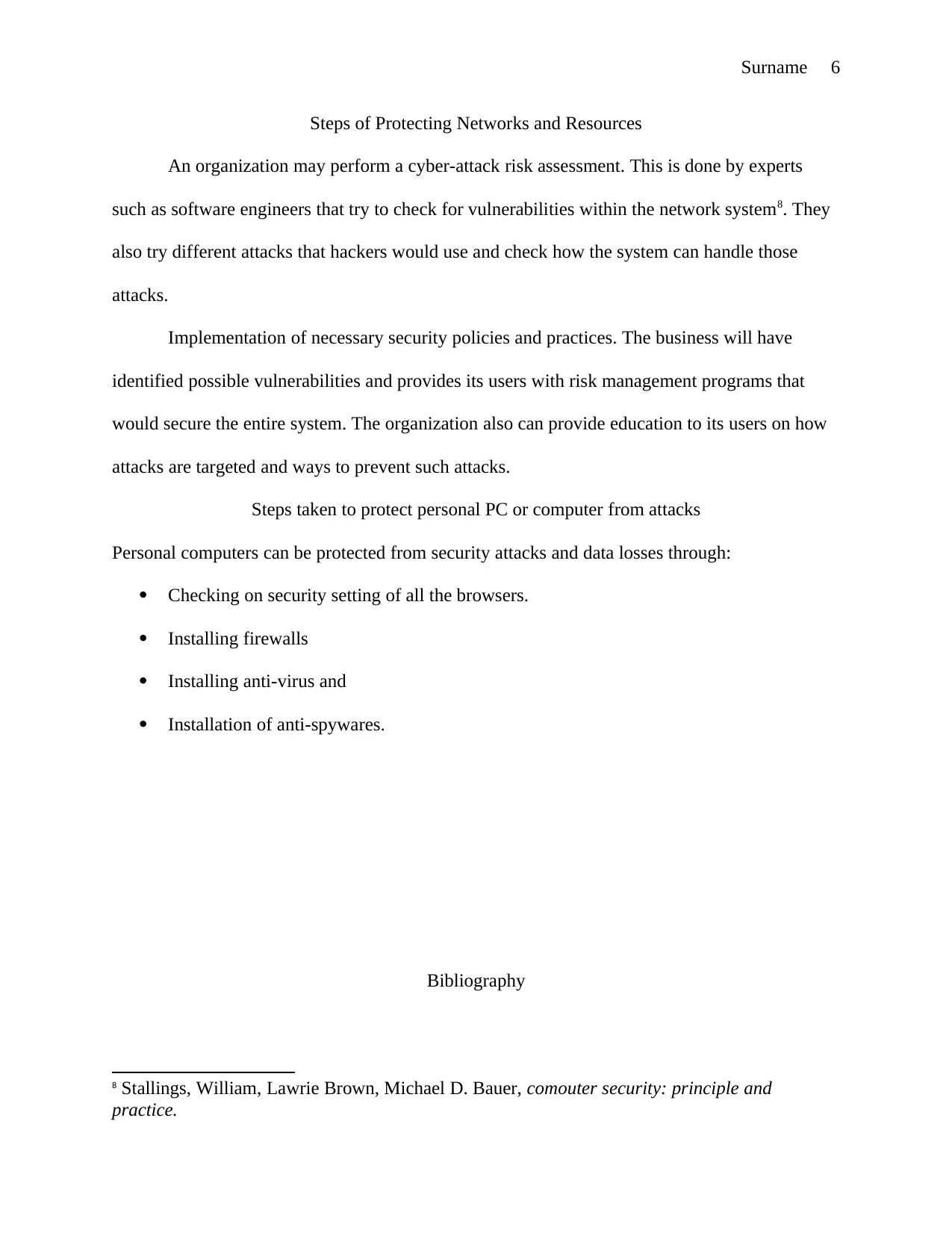
Surname 6
Steps of Protecting Networks and Resources
An organization may perform a cyber-attack risk assessment. This is done by experts
such as software engineers that try to check for vulnerabilities within the network system8. They
also try different attacks that hackers would use and check how the system can handle those
attacks.
Implementation of necessary security policies and practices. The business will have
identified possible vulnerabilities and provides its users with risk management programs that
would secure the entire system. The organization also can provide education to its users on how
attacks are targeted and ways to prevent such attacks.
Steps taken to protect personal PC or computer from attacks
Personal computers can be protected from security attacks and data losses through:
Checking on security setting of all the browsers.
Installing firewalls
Installing anti-virus and
Installation of anti-spywares.
Bibliography
8 Stallings, William, Lawrie Brown, Michael D. Bauer, comouter security: principle and
practice.
Steps of Protecting Networks and Resources
An organization may perform a cyber-attack risk assessment. This is done by experts
such as software engineers that try to check for vulnerabilities within the network system8. They
also try different attacks that hackers would use and check how the system can handle those
attacks.
Implementation of necessary security policies and practices. The business will have
identified possible vulnerabilities and provides its users with risk management programs that
would secure the entire system. The organization also can provide education to its users on how
attacks are targeted and ways to prevent such attacks.
Steps taken to protect personal PC or computer from attacks
Personal computers can be protected from security attacks and data losses through:
Checking on security setting of all the browsers.
Installing firewalls
Installing anti-virus and
Installation of anti-spywares.
Bibliography
8 Stallings, William, Lawrie Brown, Michael D. Bauer, comouter security: principle and
practice.
⊘ This is a preview!⊘
Do you want full access?
Subscribe today to unlock all pages.

Trusted by 1+ million students worldwide
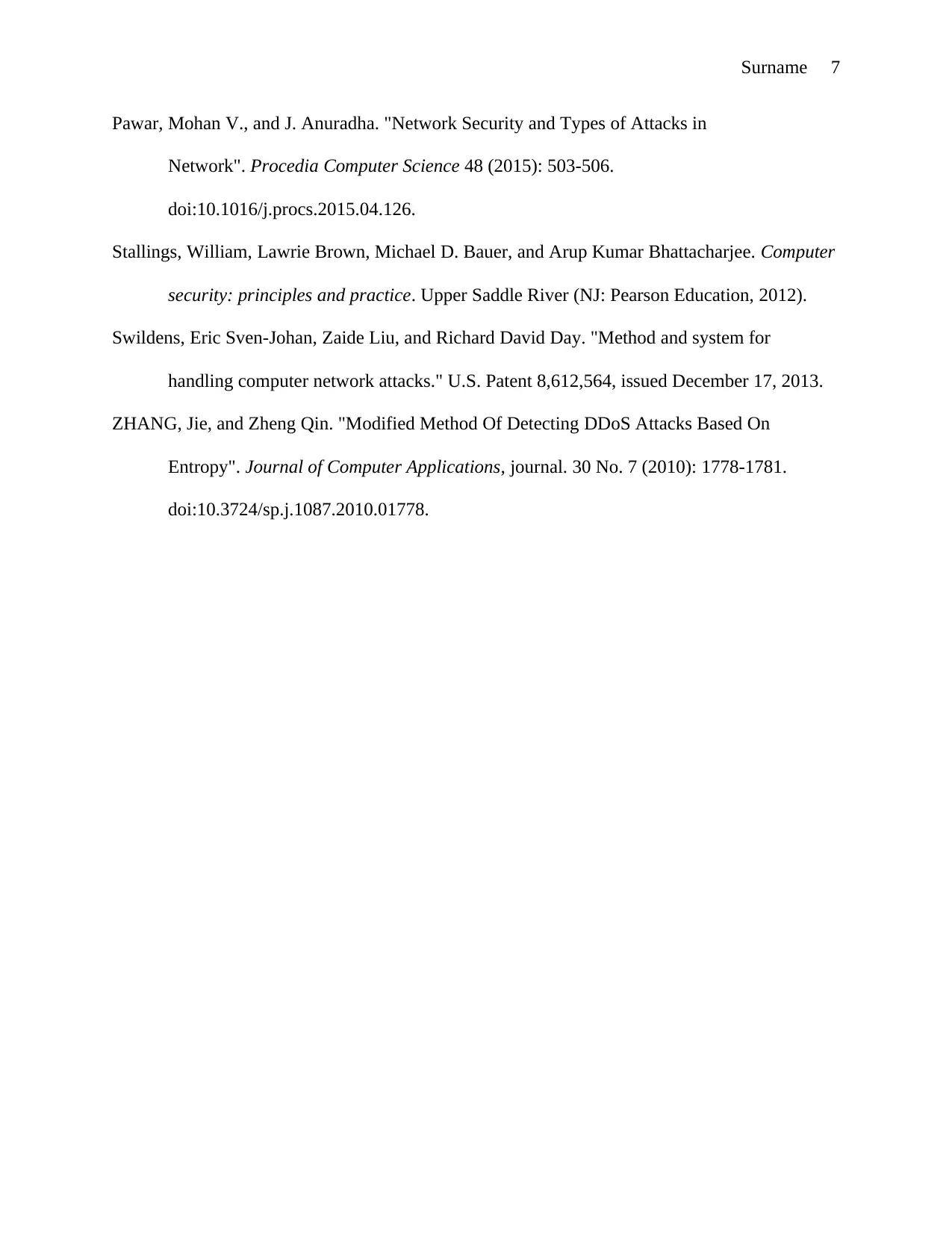
Surname 7
Pawar, Mohan V., and J. Anuradha. "Network Security and Types of Attacks in
Network". Procedia Computer Science 48 (2015): 503-506.
doi:10.1016/j.procs.2015.04.126.
Stallings, William, Lawrie Brown, Michael D. Bauer, and Arup Kumar Bhattacharjee. Computer
security: principles and practice. Upper Saddle River (NJ: Pearson Education, 2012).
Swildens, Eric Sven-Johan, Zaide Liu, and Richard David Day. "Method and system for
handling computer network attacks." U.S. Patent 8,612,564, issued December 17, 2013.
ZHANG, Jie, and Zheng Qin. "Modified Method Of Detecting DDoS Attacks Based On
Entropy". Journal of Computer Applications, journal. 30 No. 7 (2010): 1778-1781.
doi:10.3724/sp.j.1087.2010.01778.
Pawar, Mohan V., and J. Anuradha. "Network Security and Types of Attacks in
Network". Procedia Computer Science 48 (2015): 503-506.
doi:10.1016/j.procs.2015.04.126.
Stallings, William, Lawrie Brown, Michael D. Bauer, and Arup Kumar Bhattacharjee. Computer
security: principles and practice. Upper Saddle River (NJ: Pearson Education, 2012).
Swildens, Eric Sven-Johan, Zaide Liu, and Richard David Day. "Method and system for
handling computer network attacks." U.S. Patent 8,612,564, issued December 17, 2013.
ZHANG, Jie, and Zheng Qin. "Modified Method Of Detecting DDoS Attacks Based On
Entropy". Journal of Computer Applications, journal. 30 No. 7 (2010): 1778-1781.
doi:10.3724/sp.j.1087.2010.01778.
1 out of 7
Related Documents
Your All-in-One AI-Powered Toolkit for Academic Success.
+13062052269
info@desklib.com
Available 24*7 on WhatsApp / Email
![[object Object]](/_next/static/media/star-bottom.7253800d.svg)
Unlock your academic potential
Copyright © 2020–2025 A2Z Services. All Rights Reserved. Developed and managed by ZUCOL.




